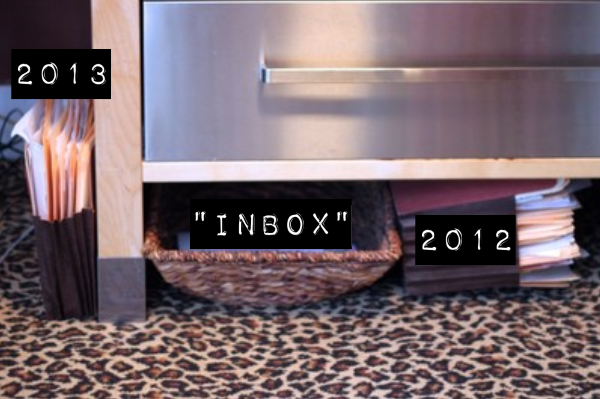
Alright, it’s February.
If you haven’t started a file for the year yet, now is a good time to get moving.
I know: boring. And may seem like a big old waste of time. But let me promise you: putting ten minutes into filing each week will save you on both time and grey hairs later, when you discover that you really really really need a form/receipt/manual/etc and poof: there it is, right there in that little folder that you so wisely allocated to it.
My system is very basic and I’m sure not perfect, but I find it super easy to manage and keep up with…and I can’t tell you how often my filing habit has come in handy. Every so often, Kendrick will be like, “Hey honey? Do you have that random piece of paper that I handed you eight months ago without telling you what it was or what I wanted you to do with it?” And I will be all, “Yes, dear. It’s filed right here in an appropriately titled, easy-to-access folder. May I get you a photocopy?”
And then I win for the day. So I think you should try it.
OK, here’s what I do:
1. Every January, I open up a new Redweld folder (one of those big reddish accordion-style folders) and write the year clearly on the front. I then use smaller file folders to create sub-categories. Everyone will have different needs when it comes to categories, but for me these are the basics:
Cars (including repair receipts, insurance documents, inspection documents); Taxes; House Expenses (including repair receipts, mortgage statements); Pay Stubs (divided by employer); Contracts (including work-related documents and scope of work statements); Phones; Utilities; Child Medical; Adult Medical; Pets (including vaccinations and receipts for vet visits); Manuals & Warranties; Retirement Accounts; Student Loans; Child College Account; Personal (including letters, cards, and artwork that I want to hold on to).
2. I keep a basket (basically an “Inbox”) in my office and throw everything that will eventually need to be either dealt with or filed into the basket. Once a week (or…ok, once a month) I sit down and go through the basket and organize everything into folders. This lets me be lazy on a day-to-day basis and only have to actually file once in awhile, while ensuring that I don’t lose any important documentation.
3. The present year’s file stays in an easily accessible location, right next to my desk and my Inbox. I also keep the previous year’s file close at hand (for things like taxes), but all other years go in neatly labeled storage boxes in the attic.
Tips:
1. Don’t be afraid to open up a new folder even if you only have one or two things to go in it; it’s much better to have clear labels for everything than to end up with a million random things stuffed into the back of your Redweld.
2. That said, there will occasionally be random papers that you aren’t sure what to do with. I keep a “Random Stuff” file that these papers go into, and just make sure not to be too liberal with what goes in there.
3. If you put a document into a folder but feel like you’re not sure you’ll remember it’s in there, don’t be afraid to write notes on the folder itself (for example, if you have folders for both ‘CAR’ and ‘RECEIPTS’ and you decide to put a receipt for your tire replacement into the ‘CAR’ folder, you may want to write a note on the folder that says “includes repair receipts”).
4. Important documents that you’ll need to access repeatedly over time (for example, documents relating to the purchase of a car or a house) should be kept in a separate file folder labeled “Important Household Documents” (or similar).
This is one of those things that you’re just going to have to trust me on and give a shot: I promise, one day you too will be stunned to discover that that random piece of paper that you never knew what to do with but suddenly desperately require is – poof! – right there at your fingertips.



